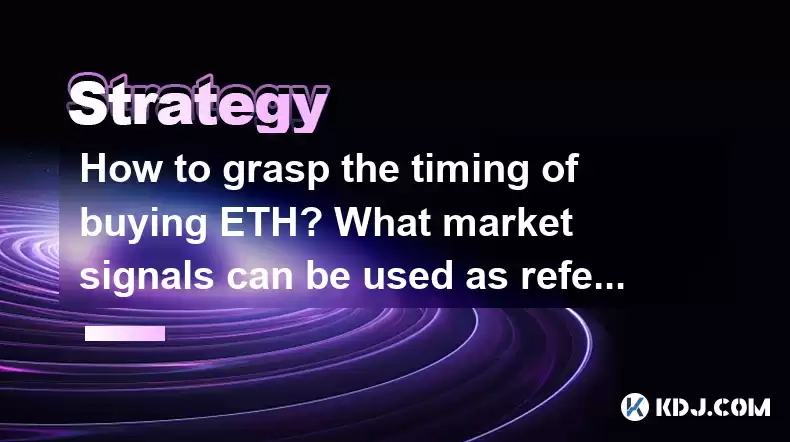-
 bitcoin
bitcoin $110918.433029 USD
-1.69% -
 ethereum
ethereum $3996.872473 USD
-2.43% -
 tether
tether $1.000594 USD
0.00% -
 bnb
bnb $1178.871834 USD
-2.38% -
 xrp
xrp $2.413973 USD
-3.47% -
 solana
solana $194.341461 USD
-4.24% -
 usd-coin
usd-coin $0.999963 USD
-0.03% -
 tron
tron $0.320092 USD
0.92% -
 dogecoin
dogecoin $0.196919 USD
-3.42% -
 cardano
cardano $0.669585 USD
-3.63% -
 hyperliquid
hyperliquid $37.485952 USD
-3.58% -
 ethena-usde
ethena-usde $1.000026 USD
-0.02% -
 chainlink
chainlink $18.018220 USD
-5.13% -
 bitcoin-cash
bitcoin-cash $523.879267 USD
-2.41% -
 stellar
stellar $0.324655 USD
-3.67%
How to grasp the timing of buying ETH? What market signals can be used as reference?
To time your ETH purchases effectively, use fundamental analysis, technical indicators like RSI and moving averages, and monitor market sentiment and on-chain metrics.
Apr 28, 2025 at 12:07 pm

Introduction to Buying ETH Timing
Understanding the timing of buying Ethereum (ETH) is crucial for any investor looking to maximize their returns and minimize risks. The cryptocurrency market, known for its volatility, presents both opportunities and challenges. To navigate this landscape effectively, investors must be well-versed in identifying market signals that can guide their buying decisions. This article will delve into the strategies and market indicators that can help you determine the optimal timing for buying ETH.
Fundamental Analysis for ETH
Fundamental analysis is a key approach to understanding the intrinsic value of ETH. This involves evaluating the underlying factors that affect Ethereum's price, such as technological developments, network upgrades, and overall market sentiment towards blockchain technology.
- Technological Developments: Keep an eye on Ethereum's roadmap for updates like Ethereum 2.0, which aims to improve scalability and security. Positive developments can lead to increased demand and higher prices.
- Network Upgrades: Monitor network statistics such as transaction volume, gas fees, and the number of active addresses. An increase in these metrics often signals growing adoption and can be a precursor to price appreciation.
- Market Sentiment: Follow news and social media to gauge the general sentiment towards Ethereum. Positive sentiment can drive prices up, while negative sentiment can lead to declines.
Technical Analysis for ETH
Technical analysis focuses on historical price data and market statistics to predict future price movements. This method involves using various indicators and chart patterns to identify potential entry points for buying ETH.
- Moving Averages: Use tools like the Simple Moving Average (SMA) and the Exponential Moving Average (EMA) to identify trends. When the shorter-term moving average crosses above the longer-term moving average, it can signal a good time to buy.
- Relative Strength Index (RSI): The RSI helps to identify overbought or oversold conditions. An RSI below 30 indicates that ETH might be oversold, presenting a potential buying opportunity.
- Bollinger Bands: These bands can help you understand volatility and potential price breakouts. When the price of ETH touches the lower Bollinger Band, it might be a good time to consider buying.
Market Sentiment and Social Media
Market sentiment can significantly influence the price of ETH. By monitoring social media platforms, forums, and news outlets, you can gauge the overall sentiment towards Ethereum.
- Twitter and Reddit: These platforms are rife with discussions about cryptocurrencies. Look for trends in hashtags, mentions, and general sentiment. A surge in positive posts can indicate growing interest and potential price increases.
- Crypto News Websites: Regularly check sites like CoinDesk and CryptoSlate for the latest news on Ethereum. Positive news, such as partnerships or regulatory advancements, can lead to price surges.
- Sentiment Analysis Tools: Use tools like LunarCrush or Santiment to analyze the sentiment around ETH. These tools aggregate data from various sources to provide a comprehensive view of market sentiment.
Volume and Liquidity Indicators
Volume and liquidity are critical indicators that can help you time your ETH purchases. High trading volumes and liquidity can indicate strong market interest and potential price movements.
- Trading Volume: Monitor the trading volume on major exchanges. An increase in volume can signal that a significant price move is imminent. If the volume is increasing while the price is stable or declining, it might be a good time to buy.
- Liquidity: High liquidity means that you can buy or sell ETH without significantly affecting the price. Look for periods of high liquidity to enter or exit positions more easily.
- Order Book Analysis: Check the order book on exchanges to see the depth of buy and sell orders. A deep order book with more buy orders than sell orders can indicate bullish sentiment.
On-Chain Metrics
On-chain metrics provide insights into the health and activity of the Ethereum network. These metrics can help you understand the underlying dynamics that might affect ETH's price.
- Active Addresses: An increase in the number of active addresses on the Ethereum network can indicate growing adoption and usage, potentially leading to price increases.
- Transaction Volume: High transaction volumes suggest increased activity and can be a positive sign for ETH's price.
- Network Hash Rate: The hash rate measures the computational power securing the network. A rising hash rate indicates a more secure network, which can boost investor confidence and drive prices up.
Frequently Asked Questions
Q: How often should I check market signals for buying ETH?A: It's advisable to check market signals daily, especially if you are actively trading. However, for long-term investors, weekly or even monthly checks might suffice, depending on your investment strategy.
Q: Can I rely solely on technical analysis for buying ETH?A: While technical analysis is a powerful tool, it's best used in conjunction with fundamental analysis and market sentiment. Relying solely on technical analysis might lead to missed opportunities or misinterpretations of market conditions.
Q: How do I know if a market signal is reliable?A: Reliability can be assessed by looking at the historical accuracy of the signal, the source of the data, and whether the signal aligns with other indicators. It's also important to consider the broader market context and not rely on a single signal in isolation.
Q: Is it better to buy ETH during a dip or a peak?A: Buying during a dip can offer better value and potentially higher returns if the price rebounds. However, buying at a peak might be justified if you believe in the long-term growth of ETH and are willing to hold through potential downturns.
Disclaimer:info@kdj.com
The information provided is not trading advice. kdj.com does not assume any responsibility for any investments made based on the information provided in this article. Cryptocurrencies are highly volatile and it is highly recommended that you invest with caution after thorough research!
If you believe that the content used on this website infringes your copyright, please contact us immediately (info@kdj.com) and we will delete it promptly.
- Binance, Bitcoin, and Ethereum: Navigating Crypto's Choppy Waters
- 2025-10-17 00:25:12
- Gold vs. Bitcoin: Market Cap Showdown and What It Means for You
- 2025-10-17 00:25:12
- ZEN Token's LCX Exchange Listing: What You Need to Know
- 2025-10-17 00:30:01
- Ripple's Billion-Dollar Bet: GTreasury Acquisition Shakes Up Corporate Finance
- 2025-10-17 00:30:01
- MiCA, Ireland, and CATI Tests: Navigating the Crypto Landscape
- 2025-10-17 00:30:01
- Coin Circulation: Unearthing Millions in Your Pocket Change?
- 2025-10-17 00:30:15
Related knowledge

Practical parameter settings for a Bitcoin multi-timeframe moving average system
Sep 18,2025 at 10:54pm
Optimizing Timeframe Combinations for Bitcoin Trading1. Selecting appropriate timeframes is crucial when building a multi-timeframe moving average sys...

How can I filter out false breakouts in Dogecoin high-frequency trading?
Sep 22,2025 at 01:00am
Understanding False Breakouts in Dogecoin Trading1. A false breakout occurs when Dogecoin's price appears to move beyond a defined support or resistan...

Techniques for identifying tops and bottoms in the Bitcoin on-chain NVT model
Sep 20,2025 at 07:54pm
Understanding the NVT Model in Bitcoin Analysis1. The Network Value to Transactions (NVT) ratio is often described as the 'P/E ratio' of the cryptocur...

What does the surge in open interest in Bitcoincoin futures mean?
Sep 20,2025 at 11:18pm
Understanding the Surge in Dogecoin Futures Open Interest1. A surge in open interest within Dogecoin futures indicates a growing number of active cont...

How can I use the Ethereum USDT premium to gauge market sentiment?
Sep 18,2025 at 11:55pm
Understanding the Ethereum USDT Premium1. The Ethereum USDT premium refers to the price difference between USDT (Tether) traded on Ethereum-based plat...

What should I do if Ethereum staking yields decline?
Sep 20,2025 at 06:18am
Understanding the Causes Behind Declining Ethereum Staking Yields1. The Ethereum network transitioned to a proof-of-stake consensus mechanism with the...

Practical parameter settings for a Bitcoin multi-timeframe moving average system
Sep 18,2025 at 10:54pm
Optimizing Timeframe Combinations for Bitcoin Trading1. Selecting appropriate timeframes is crucial when building a multi-timeframe moving average sys...

How can I filter out false breakouts in Dogecoin high-frequency trading?
Sep 22,2025 at 01:00am
Understanding False Breakouts in Dogecoin Trading1. A false breakout occurs when Dogecoin's price appears to move beyond a defined support or resistan...

Techniques for identifying tops and bottoms in the Bitcoin on-chain NVT model
Sep 20,2025 at 07:54pm
Understanding the NVT Model in Bitcoin Analysis1. The Network Value to Transactions (NVT) ratio is often described as the 'P/E ratio' of the cryptocur...

What does the surge in open interest in Bitcoincoin futures mean?
Sep 20,2025 at 11:18pm
Understanding the Surge in Dogecoin Futures Open Interest1. A surge in open interest within Dogecoin futures indicates a growing number of active cont...

How can I use the Ethereum USDT premium to gauge market sentiment?
Sep 18,2025 at 11:55pm
Understanding the Ethereum USDT Premium1. The Ethereum USDT premium refers to the price difference between USDT (Tether) traded on Ethereum-based plat...

What should I do if Ethereum staking yields decline?
Sep 20,2025 at 06:18am
Understanding the Causes Behind Declining Ethereum Staking Yields1. The Ethereum network transitioned to a proof-of-stake consensus mechanism with the...
See all articles










































































